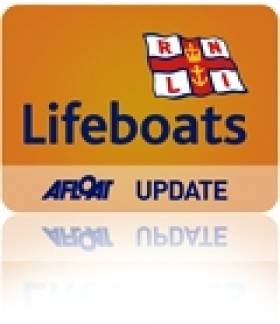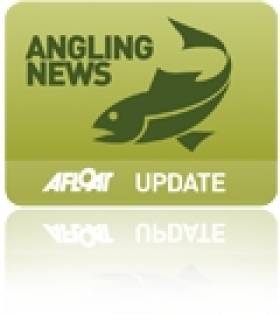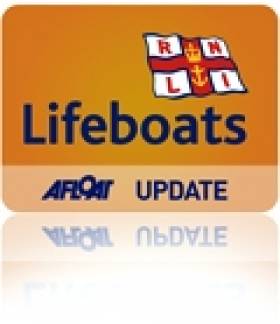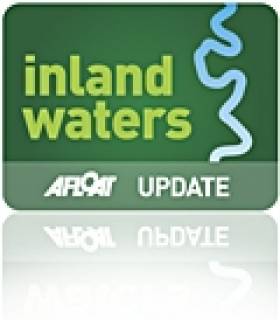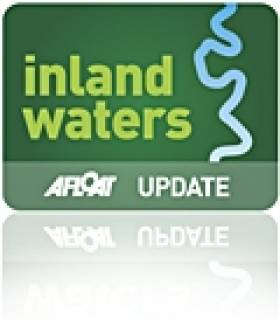Displaying items by tag: Lough Derg
Lough Derg Lifeboat Takes Boat & Jet Ski In Tow
#rnli – While out on exercise last night, Lough Derg RNLI Lifeboat came to the assistance of five people whose boat had suffered engine failure, at the south western end of Lough Derg.
At 8.30pm the Lifeboat observed a boat close to shore at Two Mile Gate, flash a distress signal with a torch. Upon investigation the lifeboat found five people, four adults and one child on board a 20ft boat that had suffered engine failure. They had contacted two friends for assistance, but having attempted to tow them, the battery on their jet ski failed.
The lifeboat crew, with Helm Eleanor Hooker, Robbie Garland and Owen Cavanagh on board, contacted Valencia Coast Guard to make them aware of the situation and to let them know that they were going to assist. The wind was a cold northerly wind, Force 2-3. Visibility was fair with failing light.
The lifeboat secured the jet ski and took the boat with her passengers and an RNLI crew member on board, under tow to their mooring at Killaloe. Once the boat was safely tied alongside, the lifeboat took the two jet skiers plus their vessel upriver and under the bridge at Killaloe to their launching slip, where they could recover their jet sk
The Lifeboat returned to Station and was ready for service again at 10.33pm.
Lifeboat Operations Manager, Liam Maloney advises all boat users to 'fully service your boats and engines before going afloat'. He added 'if in difficulty on the lake, called 999 or 112, or use Channel 16 on VHF and ask for marine rescue'.
RNLI Lifeboat Launches for Yachtsman 'Lost' on Lough Derg
#rnli – Lough Derg RNLI Lifeboat launched following a transmission on Channel 16 from a yachtsman reporting himself lost on Lough Derg.
At 8.15pm on Saturday evening, March 4, Lough Derg RNLI Lifeboat launched following a request by Valentia Coast Guard to locate a yachtsman, after he transmitted on VHF Channel 16 that was lost on Lough Derg.
The lifeboat crew were given a description of the boat, sails and sail number. The yachtsman said he had left Garrykennedy Harbour and had made way for about 'ten miles' and was now uncertain of his position. Valentia Coast Guard reported that after receiving two poor transmissions, on Channel 16 and Channel 61, they were unable to contact the vessel again.
The lifeboat launched with Helm Ger Egan, Eleanor Hooker and Peter Clarke on board. The lake was calm with no wind, visibility was good and with nightfall, a full moon.
The Killaloe Coast Guard commenced a search from Killaloe at the southern end of the lake and the Lough Derg RNLI Lifeboat searched north from Dromineer, including Kilgarvin, Terryglass, Castletown Harbours and up the Shannon to Portumna Bridge, making enquiries of the boats moored at each harbour.
When the lifeboat reported that no sighting of a vessel adrift, they were stood down.
The Lifeboat returned to station and was ready for service again at 22.10pm.
Lough Derg Marina For Sale At €500k
#loughdeergmarina – Lough Derg marina in County Clare – once Ireland's largest marina and leisure boating facility – is for sale for at €500,000, a fraction of its boom–time value.
The freshwater boating facility that boasts over 250 berths is located in the town of Killaloe, the 'water capital' of Lough Derg.
The marina that has 500 metres of lake frontage last changed hands in 2006 for €8m. It has considerable development opportunity.
The marina is situated at the southern limit of the navigable part of the River Shannon. Lough Derg Marina is within walking distance of all Balllina/Killaloe amenities including an array of established restaurants and pubs.
Killaloe is an important boating and fishing centre within the three counties of Clare, Tipperary and Limerick. An area of natural beauty, Killaloe has become a 'most preferred residential' location in this region and has excellent transport links. It is only 8 kilometres from the M7 Motorway at Birdhill, approximately 22 kilometres north east of Limerick City and approximately 38 kilometres north east of Shannon International Airport.
More details from agents here and a piece in the Irish Times here
Double Callout For Lough Derg Lifeboat In Severe Weather
#RNLI - Lough Derg RNLI launched in severe weather conditions to assist two canoeists in difficulty on the lough yesterday (Friday 9 January).
And on returning to station, the lifeboat launched again following a report from a distressed member of public that his horse might have strayed close to the Nenagh River and be in difficulty.
Following a request from Valentia Coast Guard, Lough Derg RNLI launched initially at 3pm after a member of the public raised the alarm upon sighting an upturned canoe between Holy Island and Mountshannon.
In addition the Irish Coast Guard helicopter Rescue 115 was deployed from its base at Shannon, while the coastguard lifeboat based at Killaloe was also launched and an ambulance was requested to attend.
En route to the search area, the volunteer lifeboat crew – including helm Peter Clarke, Jason Freeman and Dean O'Sullivan – were informed that they were to search for two people at the scene. Weather conditions were poor, with winds west-southwest Force 7.
Once the lifeboat arrived on scene, the crew was informed that the two people in difficulty had managed to get to land on Holy Island.
Rescue 115's crew were able to land to recover the two casualties and take them to Limerick Hospital for treatment, as they were reported to be presenting symptoms of hypothermia.
The lifeboat then returned to base at 4.04pm, and as the volunteer crew were readying the lifeboat, a distressed member of the public requested assistance as he believed his horse might have strayed into the Nenagh River.
The crew launched to investigate, but did not locate the horse either in or on the bank of the river. Speaking following the callouts, Brian Hanly, Lough Derg RNLI deputy launching authority, said: "It is crucial the public check the weather forecast before going afloat and remember that the water is very cold at this time of year."
Hanly also commended the RNLI volunteer crew for their speedy and professional response to the callout in what were testing conditions.
Lough Derg Angling Tourism Workshop Opportunity
#Angling - Do you have an opinion on how angling should be developed on and around Lough Derg?
If so, Tipperary County Council, in association with the Lough Derg Anglers Association, invites you to attend a workshop at the Abbey Court Hotel in Nenagh on 26 November at 8pm.
The workshop will address integrated development and, as part of the Lough Derg Roadmap, examine how to enhance angling tourism and Lough Derg as a key destination for angling.
It's hoped the workshop will provide an important opportunity for information gathering, exchange of views and development of proposals for the future. The key focus will be on stakeholder engagement with the integrated management of angling tourism and the environment.
Places are limited so get involved now to avoid disappointment – details are available to read or download HERE.
Lough Derg Drubbing For Some, But Dragons & Squibs Rise Above It
#loughderg – Lough Derg's annual Keelboat Freshwater Regatta in October is meant to round out the season with some gentle lake sailing for salty folk in big boats. But 2014's event last weekend was just too near a ferociously active bad weather system which had lows sometimes down to the 950s spinning around each other out in the Atlantic close to Ireland's West Coast. Thus although it was possible to get in the racing in the CH Marine Autumn Series down at Crosshaven, while the MSL Park Motors Autumn League at Howth concluded in balmy if breezy conditions across on the east coast, over to the west on Lough Derg they were lashed by the tails of two storms, and two classes failed to get any racing at all. But if you happened to be with the stately Dragons or the perky Squibs, then there was some great sport which has W M Nixon reflecting on the way our keelboat classes are developing.
Of all Ireland's lakes, it is Lough Derg which most truly merits the description of "Inland Sea'. Lough Neagh may have greater area, but in the final analysis it's only an oddly characterless shallow basin which happens to be filled with water. Lough Erne is marvellous, but too convoluted. Lough Ree has the area and the intricate coastline, but lacks the scenery. And while Lough Corrib is right up there in the beauty stakes, it's isolated from the rest of the world.
But Lough Derg – now there really is a proper inland sea. It has splendid scenery, and historic little ports with ancient quaysides all round its complex coastline, while beside them you'll find modern marinas which host an astonishing variety and number of boats, including some quite substantial sailing cruisers.
Not only is it a splendid place unto itself, but Lough Derg is part of the greater world. From it, you can undertake inland voyages to every part of Ireland, yet it takes only a day to access the sea and the oceans beyond. It's the sort of place where boating and sailing ambitions can seem endless, so it's not surprising that in recent years the Autumn keelboat regatta has become a trendy annual fixture.
Last weekend, sixty boats from four classes headed Dromineer way, to a hospitable bay and village where Lough Derg YC has been established since 1835. Keelboat racing is nothing new on Lough Derg, but boat numbers at this level is something new, and the logistics of getting the visitors launched, and organising racing on two courses when the weather was being massively unco-operative, caused something of an overload on the club system.
As well, being slightly later in October than is usual, some key members of LDYC's small core of voluntary workers afloat and ashore were already out of the country on their usual mid-Autumn breaks. So although it would have been manageable if the weather had been clement, with the main part of the racing planned for mid-lake there simply weren't the service boats and personnel available to make a sudden shift of some of the racing to a second inshore course in Dromineer Bay.
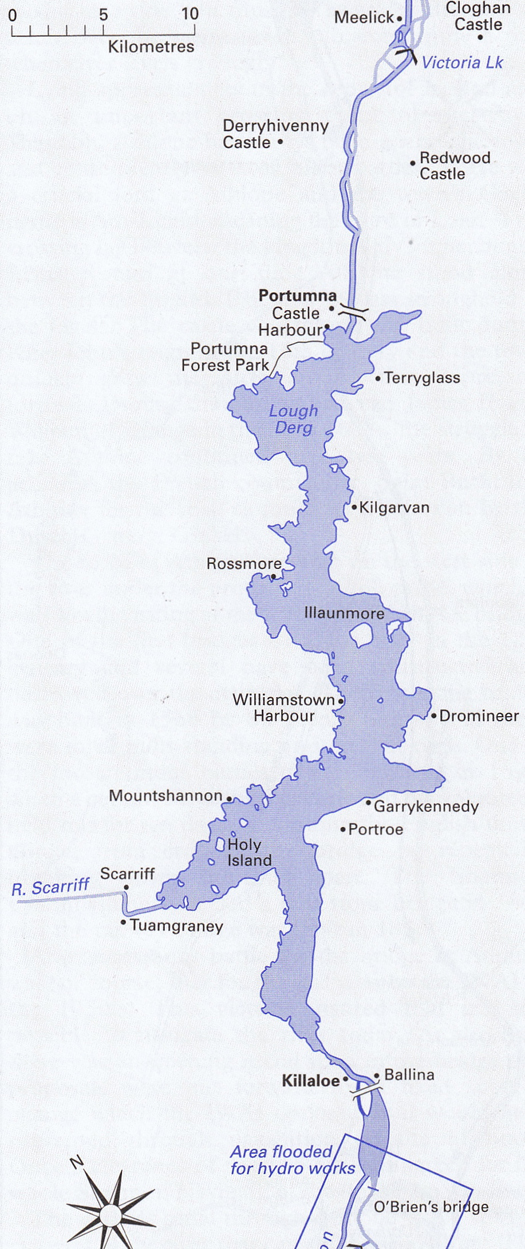
Lough Derg isn't just a lake – it's a proper inland sea with connections to the wide world.
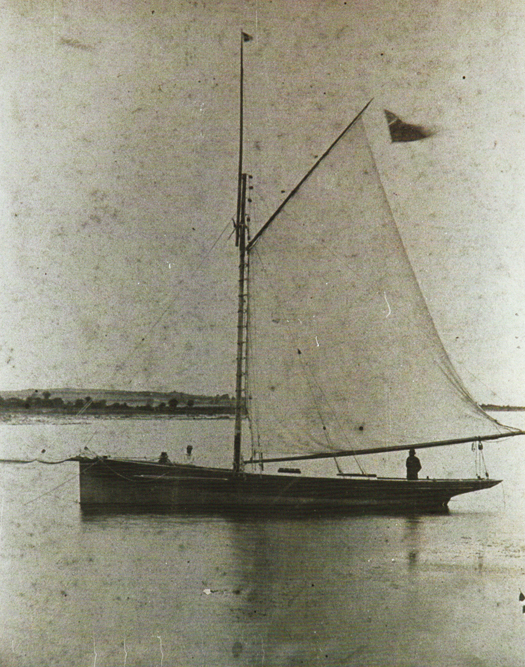
There's nothing new about keelboats on Lough Derg. This is the 7-ton cutter Tessa (Trahern Holmes, LDYC) on the lake in 1884......
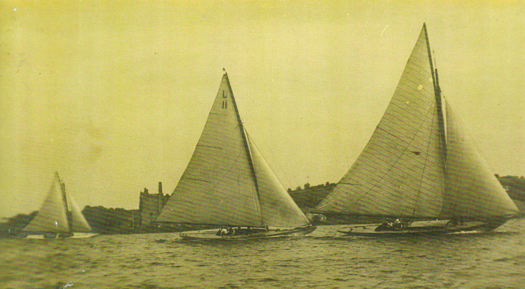
....and this is the keelboat class at Dromineer in the late 1920s. The Bermuda rigged sail number L11 is a former Olympic 6 Metre from Finland
Happily for the Dragons racing in their well-established challenge for the Jack Craig Cup, the trophy which started the whole Dromineer Autumn Keelboat event, their racing was planned for three days. In the end, they only managed the required mid-lake racing on the Friday, but it gave great sport.
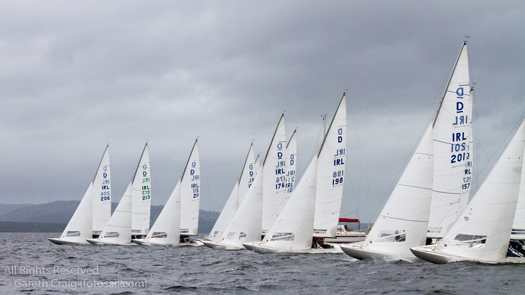 The Dragons start on the Friday. It was the introduction of the Jack Craig Cup for the International Dragons which inaugurated the Lough Derg Keelboat Regatta. The overall winner was to be Phantom (Neil Hegarty, RStGYC, no 176) Photo: Gareth Craig/fotosail
The Dragons start on the Friday. It was the introduction of the Jack Craig Cup for the International Dragons which inaugurated the Lough Derg Keelboat Regatta. The overall winner was to be Phantom (Neil Hegarty, RStGYC, no 176) Photo: Gareth Craig/fotosail
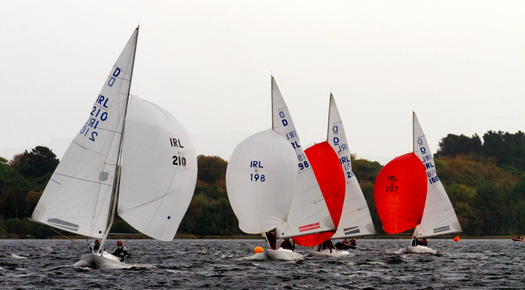
Diva (Richard Goodbody) holds the lead downwind from Dublin Bay (Gary Treacy), Little Fella (Cameron Good) and Mar J (Adrian Bendon) Photo Gareth Craig/fotosail
 When the going was good for the Dragons at Dromineer, it was very good. Gary Treacy's Dublin Bay from Dun Laoghaire and Adrian Bendon's Mar J from Kinsale neck and neck on the run, with Lough Derg YC's clubhouse and harbour on the shoreline beyond. Photo: Gareth Craig/fotosail
When the going was good for the Dragons at Dromineer, it was very good. Gary Treacy's Dublin Bay from Dun Laoghaire and Adrian Bendon's Mar J from Kinsale neck and neck on the run, with Lough Derg YC's clubhouse and harbour on the shoreline beyond. Photo: Gareth Craig/fotosail

Gary Treacy's Dublin Bay settles into the groove upwind. Photo: Gareth Craig /fotosail

Richard Goodbody's Diva showing the form which won second overall. Photo: Gareth Craig/fotosail
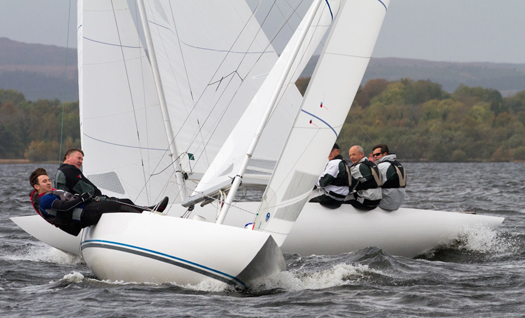
Martin Byrne's Jaguar at the finish on starboard. A former Edinburgh Cup winner, Jaguar placed third on Lough Derg. Photo: Gareth Craig/fotosail
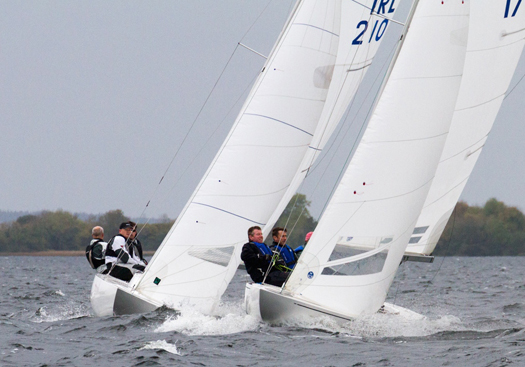
The Lough Derg 2014 Dragon Champions – Neil Hegarty's Phantom (right) won from Richard Goodbody's Diva (left). Photo: Gareth Craig/fotosail
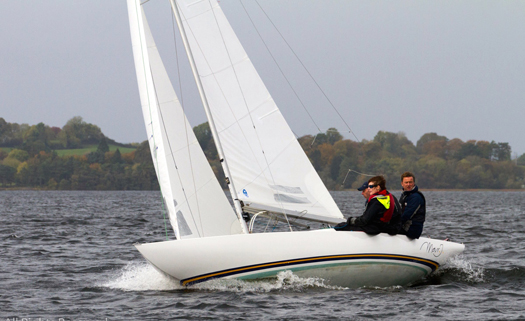 Autumn sailing at its best – Adrian Bendon's Mar J from Kinsale closes in on the finish and tenth place overall at Dromineer. Photo: Gareth Craig/fotosail
Autumn sailing at its best – Adrian Bendon's Mar J from Kinsale closes in on the finish and tenth place overall at Dromineer. Photo: Gareth Craig/fotosail
However, for the SB20s and the Flying Fifteens, trying to race the same waters on Saturday proved a non-event, and again on Sunday too. All of which made it even more galling that the Squibs, the biggest fleet of all, had requested their own simple windward-leeward course set further into Dromineer Bay on the Saturday. As long as the wind stayed in the south, the Squibs were able to race on into Saturday afternoon until, with a slight veering and further freshening of the already strong wind, all options were off.
Then on the Sunday with the wind firmly in the southwest and strong, only the Squibs had racing with one contest out on the lake, and another – with very short legs – in the inner bay. With hindsight, it seems reasonable to think that room might have been found in the bay for the two other classes of smaller boats, though admittedly the SB20s at full cry do need quite a bit of space. But that would have needed some very slick manoeuvres by more supporting RIBs, committee boats and personnel than were available.
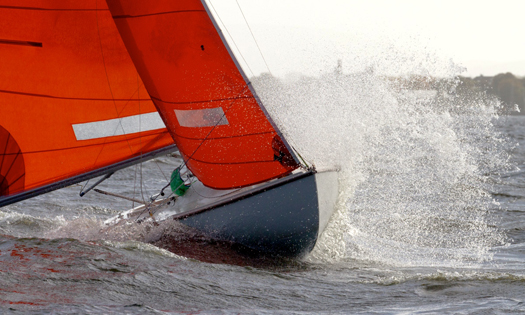
Revelling in it. Veteran skipper Vincent Delany (who also races Water Wags and Shannon ODs) puts his vintage Squib Femme Fatale (no 24) through her paces on Lough Derg. Photo: Gareth Craig/fotosail
Come to think of it, the Dragons might also have been given racing on Saturday morning if they'd been prepared to set out early and get over to the shelter of the Garrykennedy shore. But in truth, after their super sailing during Friday, the night had passed in turbo-powered conviviality, and as the Dragon crews came very slowly to life on Saturday morning on various motor-cruisers and in other accommodation, they reckoned to let the approaching storm have its way, and made arrangements to watch the rugby in the Whiskey Still in Dromineer, while other more intrepid Dragoneers battled across the lake in their vast hired Shannon motor-cruiser for a slight change of scene to watch the match in Larkin's of Garrykennedy.
But meanwhile the little Squibs were having themselves a fine old time. It was of extra interest in Dromineer, as that great stalwart of Shannon sailing Reggie Goodbody, supported by David Meredith and others, has been quietly beavering away during the past couple of years to get the Squibs going as a local class at Lough Derg Yacht Club.
As of Thursday of this week, they'd got numbers up to nine boats with others interested, which is good going from a standing start late in the summer of 2012. And though they knew that Squibs from the more experienced classes from all round Ireland would be giving them a hard time on the water, they were there ready and willing to welcome them as they drove into Dromineer on the Friday night last weekend, with twenty visiting Squibs being rigged and launched in one-and-a-half hours.
The Lough Derg people are keen to keep their new class in manageable parameters, so they've set a purchase price limit of €4,500 on people buying Squibs new to the area, which still allows for shrewd purchases in sailing centres in Great Britain, where at this time of the year it's a happy hunting ground for Squib seekers.
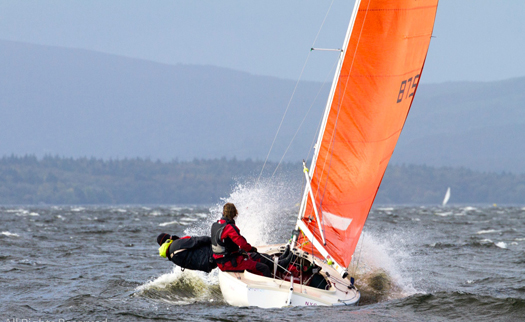
The breeze is building. One of the newest Squibs racing was Tonia McAllister's Pintail from the National YC, which finished 7th. Photo: Gareth Craig/fotosail
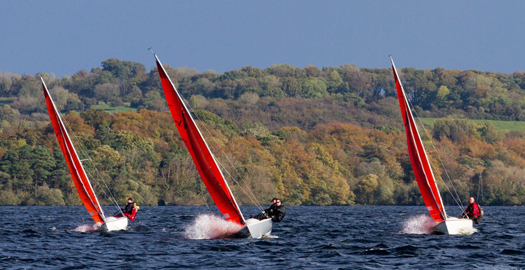 Storm? What storm? Despite dire weather predictions, at first on the Saturday morning the Squibs had perfect sailing conditions. Photo: Gareth Craig/fotosail
Storm? What storm? Despite dire weather predictions, at first on the Saturday morning the Squibs had perfect sailing conditions. Photo: Gareth Craig/fotosail
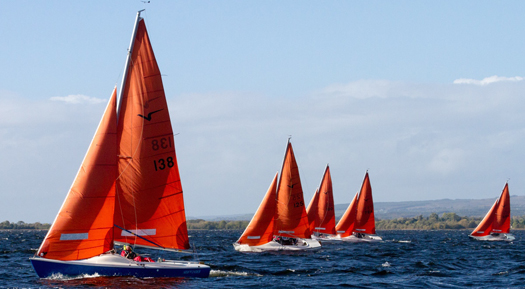 Sailing as it should be. In foreground is Rupert Bowen's Sidewinder (138, RStGYC) and beyond is clubmate Gerry O'Connor's Buzzlite (125). Photo: Gareth Craig/fotosail
Sailing as it should be. In foreground is Rupert Bowen's Sidewinder (138, RStGYC) and beyond is clubmate Gerry O'Connor's Buzzlite (125). Photo: Gareth Craig/fotosail
The attraction of the Squib for Dromineer is that it is so easily managed and maintained, a real bonus for people who may find they no longer have the energy and enthusiasm to maintain and tune a Shannon One Design, let alone the athletic ability to race one flat out. As I well recall from my own happy year of owning a Squib, they really are proper little sit-in keelboats despite being only 19ft LOA, and with our family including three small boys, a Squib proved ideal for mini-cruises along the Fingal coast and out to the islands of Ireland's Eye and Lambay, while the rapid development of the class at Howth meant we were getting good racing by the early summer of 1979.

One of the attractions of the Squib is that though she is only 19ft long, there's a proper sit-in cockpit. These are some very junior Nixons sailing on the family Squib Huppatee while returning to Howth from Ireland's Eye (hence the dinghy towing astern) in 1979. The only drawback of the Squib was she had only one tiller, so not all could steer, thus the most junior crewmember needed special consolation from his Mum.
These days the Squibs in Howth are in something of a fallow period, as many of the people who would have raced the boat in times past have moved on and up to the Puppeteer 22 which, with its little cabin and easily handled fractional rig, ticks very many boxes. However, the British & Irish Squib Championship 2015 is scheduled for Howth next June 26th- July 3rd, so doubtless that will lead to a local revival, though whether the magic number of a hundred boat racing in the same championship at the Howth venue in 1996 will be reached again is a moot point.
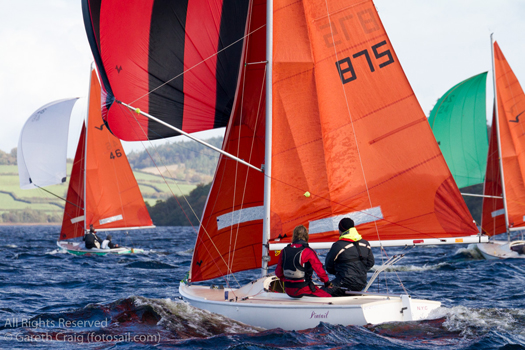
Off Dromineer, there's starting to be a real bite to the breeze as Pintail chases Femme Fatale (right) and Lola..........Photo: Gareth Craig/fotosail
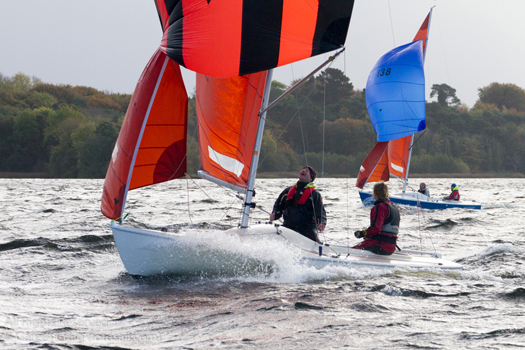
....while keeping an eye on Sidewinder off the starboard quarter. Photo: Gareth Craig/fotosail
But you never know. New boats are being built, so the class's enduring attraction is still proven, and certainly the way they got themselves back into some very confined berths at Dromineer on Saturday afternoon as further racing was being blown out was testament to their quality design and very positive handling qualities. Admittedly they may seem almost too smoothly-handling for sailing's thrill seekers, but growing classes in Dun Laoghaire and Kinsale, and the continuing health of the Squib fleets in Northern Ireland, means that the new Squib fleet at Lough Derg need never feel lonely.
That said, because the Squib has a countrywide spread, trying to keep it first and foremost a local class - as they hope to do at Dromineer - is quite a challenge. Many inshore keelboat classes today find they are becoming event boats, with crew concentrating on big happenings to which they travel perhaps every other weekend, or every three weeks or so, and they simply don't bother trying to keep up the twice-weekly commitment of club racing.

Experiment under way. Jill Fleming of Dun Laoghaire was testing a new variant on Squib sails, but although her rig looked very potent, she was back in 8th place overall with seven suits of standard tan sails ahead of her. Photo: Gareth Craig/fotosail
Certainly that's often the case with the Dragons, but then the Dragon class in Ireland offers its members a very attractive package of events all round the country at the most pleasant and glamorous sailing centres. Thus Dragon racing today in Ireland is a high-powered and potentially very expensive way of sailing, and just about as far removed as possible from Reggie Goodbody's ambitions for inexpensive Squibs at Dromineer.
He hopes to see the them develop as a good-value local class which will bring life back to Lough Derg Yacht Club during the more everyday times, when there isn't a championship going on, or it isn't the annual Lough Derg Week in August. This isn't at all the style of the Dragons' jet-setters – they're big-event performers.
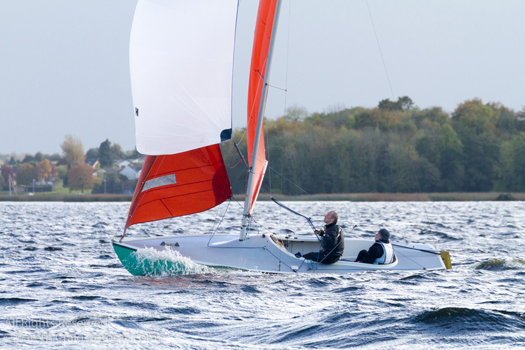
Cool sailing. One of the reasons the Squib appeals to former Shannon One Design sailors in Dromineer is that even on a busy run, you can still be relaxed and comfortable (very comfortable for the helmsman), whereas a SOD would be providing a hairy ride. Photo: Gareth Craig/fotosail
So it was fascinating to see the two very different classes sharing the lake and harbour space at Dromineer, though it was clear that if you wished to take the cheque book sailing route, the Squibs offer that as well, so Reggie and his team will have to keep the expenditure lid very firmly clamped in place.
The racing results well reflected the nationwide appeal of this event, for though the Dragons may seem to have emerged with a Dun Laoghaire dominance, winner Neil Hegarty of Royal St George YC originally hailed from Cork, and Cameron Good of Kinsale was consistent with a 6th and 3rd to take fourth behind two Dublin Bay boats.
In the Squibs, James Matthews and Rob Jacob of Kinsale racing the vintage Mucky Duck were notably consistent with a final scoreline of two firsts, a second and a third, but almost equally good were Gordon Paterson and Ross Nolan of Royal North of Ireland YC with two firsts, a second and a fifth. Another RNIYC boat from Cultra, Des and Chris Clayton's Inismara, got into the frame with the win in the final race, and the complete Squib scoreline shows the longterm health of the class, as the top six boats range in sail numbers from 24 to 820.
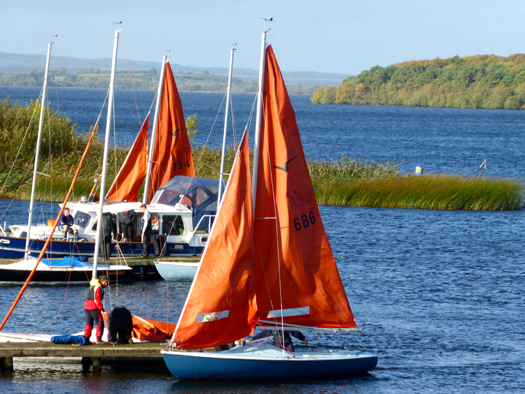
The Squibs might have been invented with Lough Derg YC's facilities in mind, as they are easy to berth on the outer harbour....Photo: W M Nixon
 ...yet even in an awkward breeze, they can head confidently for the narrow little East Dock.......Photo: W M Nixon
...yet even in an awkward breeze, they can head confidently for the narrow little East Dock.......Photo: W M Nixon
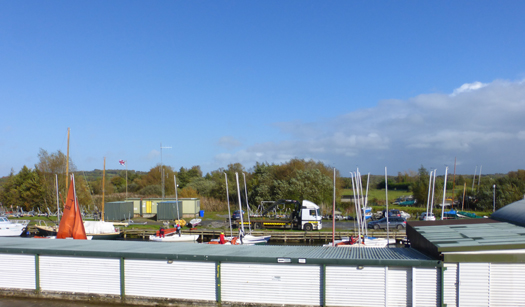
....and stay nicely under control while assessing the situation. This is Peter Kennedy's Whipper Snapper, which was top of the local boats at 11th overall in the Dromineer regatta. Photo: W M Nixon
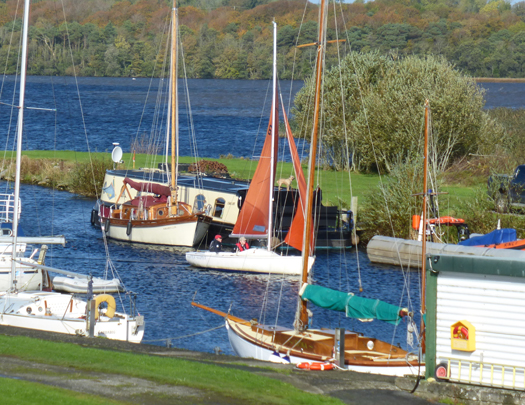
The Squib is so well mannered she'll wriggle up the most unlikely channel whatever the wind.........Photo: W M Nixon
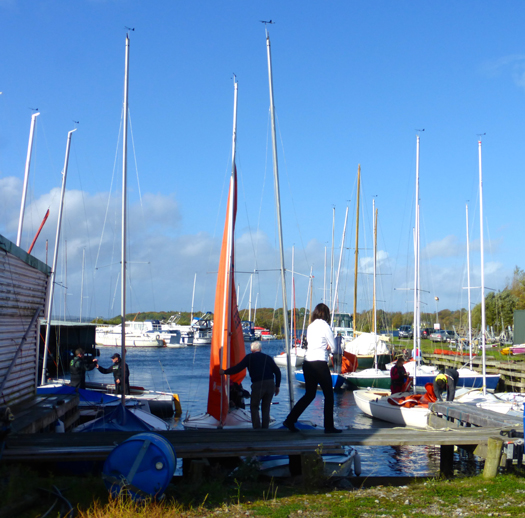
....and so Whipper Snapper reaches her berth right at the top of the dock with no bother at all. Photo: W M Nixon
As to the longterm health of the event, despite this year's problems for which we have to make some allowance for the extreme weather, there's no doubt everyone very much wants Dromineer to succeed as the venue for what has the potential to be a major and rather special keelboat regatta.
But as an outside observer who has been notably unsuccessful in running races himself, it seemed to me that when number start pushing towards the sixty mark and four classes are involved, then the visiting classes will have to expect to be bringing back-up support boats and some race officials with them. And that in turn will require a certain amount of diplomacy between the visitors and the established race administration at the hosting club. Yet that would be well worth the effort. For when the going was good at Dromineer, it was very good indeed.
LOUGH DERG YACHT CLUB KEELBOAT REGATTA 2014
International Dragon Class: 1st Phantom (Neil Hegarty, RStGYC) 3pts; 2nd Diva (Richard Goodbody, RIYC) 4pt; 3rd Jaguar (Martin Byrne, RStGYC) 7 pts; 4th Little Fella (Cameron Good, KYC) 9 pts; 5th Sir Ossis (Denis Bergin, RIYC) 13pts; 6th Cloud (Claire Hogan, RStGYC) 14pts. (15 raced).
National Squib Class: 1st Mucky Duck (James Matthews, KYC) 7pts; 2nd Quickstep (Gordon Paterson, RNIYC) 9pts; 3rd Inismara (Des Clayton, RNIYC) 15pts; 4th Fagan (Cian O'Regan, KYC) 15pts; 5th Femme Fatale (Vincent Delany, RStGYC) 15 pts; 6th Perfection (Jill Fleming, RStGYC) 17pts; 7th Pintail (Tonia McAllister, NYC) 37pts; 8th Sidewinder (Rupert Bowen, RStGYC) 40 pts (23 raced).

When the going gets too rough on Lough Derg, the prudent Dromineer mariner will seek a secure berth in the Whiskey Still to watch the rugby. Photo: W M Nixon
#rnli – The RNLI are inviting the public to a meetingabout plans for a permanent Lough Derg RNLI Lifeboat Station in Dromineer . The public will meet the architects/engineers at a consultation on the Station plans for Lough Derg. The meeting will take place at Lough Derg Yacht Club, Wed. October 15 from 7-9pm.
The Lough Derg RNLI Lifeboat Station, began operations from the premises of Lough Derg Yacht Club at Dromineer, halfway down the east shore of the lake in County Tipperary. Now that plans for our new permanent Station in the village are well underway, it is important the the public become engaged with the consultation process for the new permanet station location in their locality.
On May 25, 2014, the Lough Derg RNLI Lifeboat Station celebrated its tenth birthday. In those ten years, the lifeboat has launched 240 times, 60 of those at night. Volunteer crews have rescued 340 people and saved the lives of three people.
Following a rescue August 13 of this year, the Skipper of the vessel wrote this letter to our Lifeboat Operations Manager, Mr. Liam Maloney (quote used with kind permission).
The lifeboat reached us within 20 minutes of my call and towed us to the safety of Shannon Sailing Dromineer. [...]
It would be hard to do justice to the spped and manner in which all those people concerned responded to my emmergency call, including the operator who answered my radio call.
For many years the RNLI and the lifesaving work of its volunteers, have enjoyed the strong support of the people of Nenagh through the tireless efforts of campaigners in the RNLI's expanding fund raising committee, chaired locally by Niamh McCutcheon. The RNLI is a charity that saves lives, it does not receive Governent grants and relies entirely on the contributions and legacies from the public to continue its vital operations.
Lough Derg RNLI Lifeboat Station is one of forty four RNLI Stations operating in Ireland. A local application to station an RNLI lifeboat on Lough Derg, led by Charles Stanley Smith and Teddy Knight, became reality, when, on 25 May 2004, the Lough Derg RNLI Lifeboat officially began service. In the preceding year and a half, volunteer crews and members for the Operations Committee were recruited and underwent intensive training on the water and in the classroom, with RNLI Divisional Trainer Assessor Helena Duggan - our Trainer Assessor to this day.
Lough Derg is one of three RNLI inland Stations in Ireland, the other two are located at Lough Erne Yacht Club, Enniskillen, County Fermanagh in Northern Ireland and our sister Station on the river Shannon, at Lough Ree.
Lough Derg is the lowest, and at twenty-seven miles long, the largest of the series of lakes on the river Shannon, the longest river in the Republic of Ireland. The shores of Lough Derg are bordered by three counties with the most outstanding countryside. It has secluded lagoons that can be accessed by narrow rivulets and many public and private harbours.
It is a beautiful, serene and charming freshwater lake. However, it can be provoked by high winds that funnel between the hills that border its southern narrower stretches of water. With little warning Lough Derg suddenly becomes an unforgiving sweep of water. At Parker's Point, where two stretches of the lake meet from the west and from the south, the water depth decreases sharply from one hundred and twenty feet to less than twenty feet. In a south westerly these factors combine to produce extremely confusing seas, with waves that come from the two directions at once to produce treacherous steep 'pyramid' waves. It is at this point on the lake that vessels frequently get into difficulties.
In the past Lough Derg was a major conduit for the passage of people and trade goods along the river Shannon. Nowadays the lake is used for pleasure by fishing and sailing boats, cruisers and barges. By necessity the rescue services must be present and ready to deal with increasing traffic and any possible difficulties that might ensue. Lough Derg is ready to do that, with volunteers on call twenty fours hours a day, every day of the year
Iniscealtra's Hanse 34 Wins Lough Derg's Long Distance Gortmore Bell Prize
#loughderg – Iniscealtra Sailing Club and Garykennedy Sailing Club hosted the annual 24–mile long Gortmore Bell Race on Lough Derg at the weekend, 36 sailing boats ranging from one design types such as 1720s and J24s plus a good mix of 28ft to 34ft cruiser–racers competed. Conditions for the Lough's long distance race were ideal with wind speeds ranging from eight and 14 knots from the north–east.
The course for the 2014 race was from a start Line in Mountshannon Bay to the Gortmore Green Navigation Mark rounded to Port, thence to Coose Bay Red Navigation Mark to port, Mountaineer Green Navigation Mark to starboard and a finish in Mountshannon Bay.
The winning boat boat was the Hanse 34 sailing cruiser, Dash, skippered by Dan O'Donnell of Iniscealtra Sailing Club.
Waterways Ireland Praises Tourism Potential Of Holy Island
#HolyIsland - Waterways Ireland's chief executive has said the agency would be "delighted" to work with Clare County Council to develop improved public access to Holy Island on Lough Derg.
Dawn Livingstone was speaking following a visit to Holy Island during which she was briefed by the local authority on its plans to secure the purchase of the island, as previously reported on Afloat.ie.
Regarded as one of the most important historical and ecclesiastical sites in Ireland, the island comprises some 50 acres, of which more than four acres are in the ownership of the Office of Public Works (OPW).
"Waterways Ireland would be delighted to work in partnership with the council to develop better access to Holy Island as part of a management plan for care of the important ecclesiastical monuments on the island has been developed," said Livingstone.
"Holy Island is one of a number of important historic sites associated with the inland waterways, which Waterways Ireland believe linked together form a heritage trail that would also bring new visitors to the waterways and local areas."
Livingstone was accompanied on her visit to Holy Island by Gerard Dollard, director of services with Clare County Council, who confirmed that the local authority is presently putting funding in place and signing contracts to acquire the land, and said the council "warmly welcomes" Waterways Ireland's interest in the project that would go up for consultation with "all stakeholders and the local community" following the purchase.
Holy Island lies close to the village of Mountshannon and is on the UNESCO World Heritage site tentative list as an Early Medieval Monastic site along with Clonmacnoise, Durrow, Glendalough, Kells and Monasterboice.
The island also has important links to Brian Ború and is known throughout East Clare as the 'Jewel of the Lough'. Still used as a burial ground, the ruins and buildings still standing on Holy Island date back as far as the 7th century when the monastic site was established by St Caimin. Tom MacSweeney has more on the island in his latest This Island Nation.
Lough Derg Gets Its Own Dedicated Tourism Website
#loughderg – Minister for the Environment, Community and Local Government Mr. Alan Kelly TD today launched a brand new website dedicated exclusively to the promotion of the inland waterways of the Lough Derg region.
www.discoverloughderg.ie provides visitors to the region with information on places to visit, events, accommodation providers and restaurants, special offers, and land and water based activities.
The website is one of a number of marketing initiatives being rolled out over the coming months and during 2015 to establish the Lough Derg area in counties Clare, Galway and Tipperary as Ireland's premier lakeland destination.
"Lough Derg is the most important tourism asset in this region, and the lake has the capacity and the potential to entice and host domestic and international visitors alike," stated Minister Kelly at the launch of www.discoverloughderg.ie.
The Minister added: "We need to continue to work on increasing the demand for lakeside and leisure activities and attract tourists into the Lakelands Lough Derg Region. An online presence is just one activity to assist us in doing this".
Minister Kelly confirmed that a €2million stimulus package is being invested to progress the objectives of the "Roadmap for Experience Development and Destination Marketing Plan 2014-2017" for Lough Derg, which was launched earlier this year.
Implementation of the Plan is being co-ordinated by the Lough Derg Marketing Group (LDMG), comprising Fáilte Ireland, Waterways Ireland, Inland Fisheries, Clare, Galway and Tipperary County Councils, LEADER and tourism trade representatives from the private sector.
In addition to the website, the LDMG has coordinated a promotional video for the Lakelands Lough Derg Region, which is available to view on the newly launched website and which local tourism businesses are encouraged to incorporate into their websites. Lakelands Lough Derg will also be promoted on websites across France and Germany later this year, while a domestic marketing campaign is planned for the national print and broadcast media in early 2015.
Joe MacGrath, LDMG Chairperson and Chief Executive of Tipperary County Council commented: "One of the key objectives outlined in the Roadmap is to improve orientation around Lough Derg for visitors. This will be achieved by erecting new signage to create a sense of arrival and enhance the visitor experience in exploring the area. It will focus on the three counties of Clare, Tipperary and Galway that border the lake with signage from motorways to the regional and local roads included in the scheme. Work is progressing in relation to this project and new signage is expected to be put in place in 2015".
"The marketing and promotion of Lough Derg is an ongoing process," explained Áine Mc Carthy, Tourism Marketing Coordinator for Lough Derg, who added: "For example, the Lough Derg Marketing Group launched a pilot food tourism initiative, A Taste of Lough Derg 2014, in June of this year which became an instant success generating public attention on social media through a series of events organised by the tourism trade in July and August. The initiative, which continues this month has created a significant interest in local produce available around Lough Derg and has heightened awareness of Lough Derg as a food tourism destination".
"The initiative will be extended next year to get more of the tourism trade involved, with more events taking place throughout the summer months offering visitors to Lough Derg a choice of food events to attend," added Ms. Mc Carthy.
Meanwhile, the LDMG has been involved in an EU Project called TRAP (Territories of Rivers Action Plans) since March which involves improving stakeholder engagement around Lough Derg.
Businesses wishing to be added to www.discoverloughderg.ie or to have their details updated should send an email to [email protected].




























